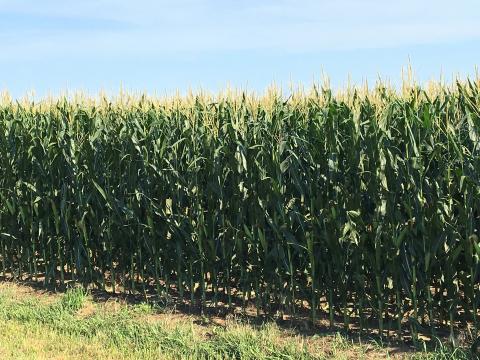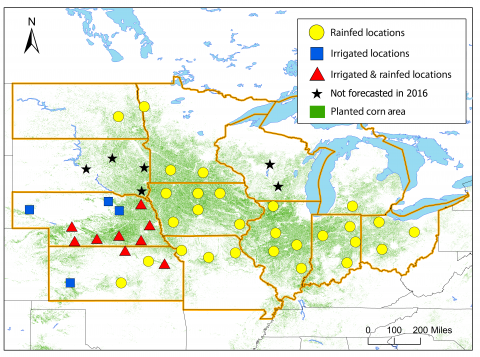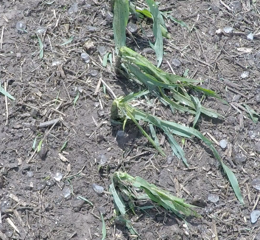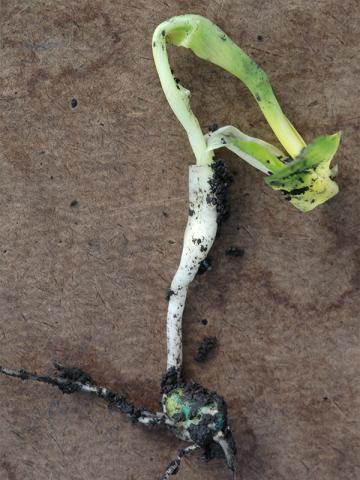Biomass Production of Winter Annual Cover Crops in Corn and Soybean
August 11, 2016
Rye was the leading biomass producer in the first two years of a four-year study exploring whether winter cover cropping in no-till corn and soybean systems in Nebraska can benefit soil quality despite their short growing season.
2016 Corn Yield Forecasts as of July 27
July 28, 2016
Corn yield forecasts, based on Hybrid-Maize simulations and input from crop experts in 10 states, were developed for 41 sites across the Corn Belt on July 27. For irrigated corn, based on this conditions at this point in the season, there is only a low probability of below average yields. For rainfed corn, the majority of the sites studied, the results are more variable across locations. The article includes yield forecasts for each site, along with conditions for the period contributing to the forecasts.
2016 Corn Yield Forecasts as of July 13
July 14, 2016
Based on modeling corn growth stage and end-of-season yield for 41 sites in 10 Corn Belt states, researchers are forecasting potential end-of-season yield in "real time" to aid in decision-making thoughout the season. On July 14 they reported that corn has already reached or is approaching silking throughout most of Nebraska and the Corn Belt, except for corn in the northern and eastern states, where growth is running behind the rest of the region.based on modeling end-of-season corn yield for 41 sites. There is a low (<20%) probability of below-average yields at all irrigated locations, except for two sites in southeastern Nebraska. The range of forecast yields at the rainfed sites is wider. There is a relatively high probability (>75%) of above-average yield at two locations in the northern states and below-average yield at three locations. See story for predicted yields and probabilities for all the sites.
2016 Corn Yield Forecasts: Approach and Interpretation of Results
June 30, 2016
The Yield Forecasting Center will be providing in-season corn yield forecasts every two weeks starting in mid-July to aid growers and the ag industry in making management, logistics, and marketing decisions through the season. The Center consists of a core team at UNL in collaboration with agronomists and extension educators from universities throughout the Corn Belt.
Why are Emerged Corn Seedlings Yellow?
May 19, 2016
The yellow hue to corn seedlings reported in multiple fields this week may be indicative of several conditions, but is likely due to the cool wet weather plants have experienced since emergence. The symptoms do not necessarily point to a nitrogen or potassium deficiency which may also cause a yellow hue. In addition, corn seedlings subjected to water-saturated soils, soil compaction, and certain herbicide applications may appear yellow.
Hail Damage in Corn
May 11, 2016
Yield losses from hail storms will depend on the timing and severity of the hail, and subsequent environmental conditions. Regardless of the level of damage, farmers should be patient when evaluating early-season hail damage in corn and wait 7–10 days after a hail event to allow for crop regrowth. See more on replant decision, yield potential of surviving plants, hail and bacterial plant pathogens.
Planting Delays? It's too Early to Consider Switching Hybrids or Moving to Soybeans
May 4, 2016
While corn planting has been delayed in areas of the state due to recent rains, it's too early to consider switching hybrids or switching to soybeans. The author addresses some key points to consider for those waiting to plant and those who planted early and may need to assess stand viability.
10 Steps for On-Farm Research Success
April 21, 2016
Interested in testing a practice or product under your field conditions and available equipment? Here are 10 steps to help ensure your results are reliable and meaningful to your operation.








